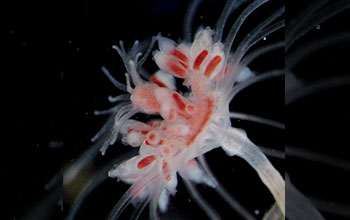Multimedia Gallery
Female Ectopleura polyp
A female Ectopleura polyp showing gonophores that are brooding offspring.
More about this image
University of Kansas (KU) scientists have discovered that polyps have no qualms about treating a nonrelated individual like part of the family. Polyps of the marine hydrozoan Ectopleura larynx allow nonrelated individuals to fuse their bodies to the familial colony and share what is essentially skin and a stomach.
The polyps are plankton-eating Hydrozoa -- relatives to jellyfish and sea anemones -- that live in shallow waters, sharing precious space and scarce resources in a spot of the ocean that’s teeming with life, from barnacles and clams to other hydrozoans. Each individual polyp is about a centimeter long and bright pink. A colony fits in two cupped hands.
Previous research by Paulyn Cartwright, a professor of ecology and evolutionary biology at KU, found that unlike their loner relatives, Ectopleura larynx form colonies of "baby" polyps that fuse to the "mother" and share a gastrovascular cavity -- basically, a stomach.
"We just got our minds wrapped around the idea that moms and offspring are fusing and sharing resources and that they’re related, but this was very surprising," Cartwright said of seeing nonrelated individuals as part of one, big happy family. "And they don’t seem to have a problem with it."
These particular polyp colonies are different from others in that they are not simply composed of a mother cloning itself. Rather, they reproduce sexually, and the offspring fuse to the parent.
The KU scientists set out to examine the genetic relationships between the polyps of the colony and expected to find individuals that were genetically identical or at least as similar to one another as siblings or as similar as parents to children. What the team didn’t expect to find was that in addition to close relatives, there were genetically unrelated polyps that fused onto the colony.
"This is super unusual given that in a colony, they end up sharing everything from a continuous outer epithelia to an entire digestive system," Sally Chang, a doctoral candidate, said.
"In the ecological context that they’re in, it appears that there’s a tradeoff," Cartwright said. "You could be a tiny little thing with one mouth, or you could fuse with mostly relatives and once in a while a stranger and be a big individual with lots of mouths."
The research was supported in part by the National Science Foundation (grant DEB 0953571).
Learn more in the NSF News From the Field story Polyps will let unrelated 'others' fuse to them and share tissue, scientists discover. (Date image taken: 2013-2017; date originally posted to NSF Multimedia Gallery: Dec. 17, 2018)
Credit: Paulyn Cartwright, University of Kansas
Images and other media in the National Science Foundation Multimedia Gallery are available for use in print and electronic material by NSF employees, members of the media, university staff, teachers and the general public. All media in the gallery are intended for personal, educational and nonprofit/non-commercial use only.
Images credited to the National Science Foundation, a federal agency, are in the public domain. The images were created by employees of the United States Government as part of their official duties or prepared by contractors as "works for hire" for NSF. You may freely use NSF-credited images and, at your discretion, credit NSF with a "Courtesy: National Science Foundation" notation.
Additional information about general usage can be found in Conditions.
Also Available:
Download the high-resolution JPG version of the image. (530.3 KB)
Use your mouse to right-click (Mac users may need to Ctrl-click) the link above and choose the option that will save the file or target to your computer.

 All images in this series
All images in this series